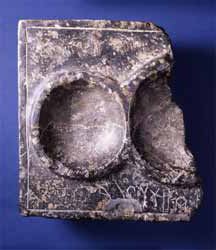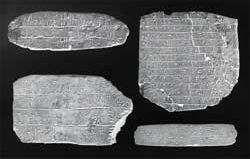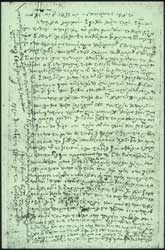Written records
 Libation table from the Dictaean Cave, with Linear A inscription. Ashmolean Museum (inv. ae.1). Courtesy of the Ashmolean Museum, University of Oxford. |
Archaeologists also, whenever possible, make use of written records. The nature of those records, and the problems in their interpretation, vary from epoch to epoch.
For the Bronze Age there are palatial records from various places in the Aegean and Near East. On Crete in the First Palace period Linear A was used both to dedicate objects, and for record-keeping.
 Linear B tablets. Ashmolean Museum (inv. 1910.211, 212, 218, 1838.43). Courtesy of the Ashmolean Museum, University of Oxford. |
In the Second Palace period Linear B was used extensively for bureaucratic record-keeping, mainly lists of people and commodities such as wheat or chariot wheels!
 Gortyn: view of law code inscribed on rear wall of Odeion (1982). © Simon Price |
In the Graeco-Roman epoch on Crete writing was used for a variety of public purposes: to record laws and public decrees; to dedicate objects and buildings; to commemorate individuals on their tombstones. For example, at Gortyn in the Classical period the community decided to inscribe the entire law code on the wall of a monument in the main square.
This text remained the official code of the city down to Roman times, when the monument was rebuilt as part of the rear wall of the city's council house. The law code gives very valuable information about the city's social organisation. Tombstones giving the name of the deceased can also be valuable: the pattern of names in two regions can show something of the pattern of contacts between those regions.
 Pasturage treaty between Skordyli and Valeriani (1435). © Epetiris Etaireias Kritikon Spoudon. |
In the Mediaeval-Modern epoch inscribed documents are less important, and instead we can make use of private documents (which existed in earlier epochs, but do not survive on Crete). For example, two families in the fifteenth century which had been engaged in a bitter and deadly feud over grazing rights in Sphakia decided in the end to come to terms, and cemented the new relationship with a marriage alliance between the two families. There survives a copy of the original document laying out the background and the terms of the marriage.
From this epoch we also have the writings of numerous western travellers who visited Crete. One of the most interesting of them is Robert Pashley, who toured round the island in 1834. His book is a splendid account of the monuments, history and social customs of the islanders. (See Unit 2 Session 1 Lesson 4 for a more in-depth look at Robert Pashley.)